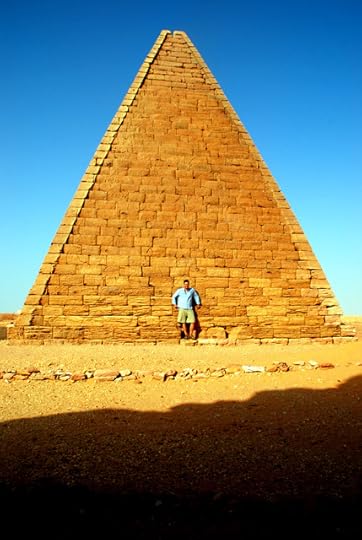The pyramids of Napata, Sudan, Day 296
I sleep reasonably well in the Sahara desert, staring up at the stars; Christi less so. She says she couldn’t get comfortable. As Christi rolls up her sleeping bag she uncovers a nest of scorpions, which just might explain her uncomfortable night. Damn this desert is dangerous. Abdul, who slept soundly in the back of the Land Cruiser, makes breakfast then it’s back to Jebel Barkal for morning shots of the pyramids of Napata. I’m trying desperately not to overwhelm you all with too much information about the history of Egypt because there is a lot of it and it is complicated. However, I think there needs to be a little explanation as to why Sudan has Egyptian-style funereal pyramids.
OK, take a deep breath and off we go. In antiquity the modern town of Karima was the city-state of Napata in Nubia (a region along the Nile encompassing northern Sudan and southern Egypt). Napata was founded by the Pharaoh Tutmosis III (remember him? His step-mother Hatshepsut usurped his throne for a couple of decades) in the 15th century BC after his conquest of Nubia. The nearby Jebel Barkal marked the southern border of the Egyptian empire. The tables were turned 750 years later (talk about revenge being a dish best served cold) when the Nubian Kingdom of Kush based in Napata expanded northwards and subjugated most or all of Ancient Egypt, forming the 25th dynasty. This dynasty ushered in a renaissance period for Ancient Egypt where religion, the arts, and architecture were restored to their glorious Old, Middle, and New Kingdom forms. Pharaohs, such as Taharqa, built or restored temples and monuments throughout the Nile valley, including at Memphis (south of Cairo), Karnak (Luxor), and Jebel Barkal. Indeed, it was during the 25th dynasty that the Nile valley saw the first widespread construction of pyramids (many in modern Sudan) in over 500 years. The pyramids of Napata at Jebel Barkal date from 300 BC.
The sanctuary of the Temple of Mut is literally carved into Jebel Barkal itself. The caretaker unlocks the door protecting the sanctuary and proceeds to explain the meaning of the hieroglyphs and relief carvings. It does seem odd to see such obvious Egyptian iconography in modern-day Sudan. But best of all, Christi and I get to enjoy theses exquisite artefacts in complete peace; we are the only tourists there. In fact, we might be the only tourists within 500 km.
Next we cross to the West Bank of the Nile for more pyramid watching at Nuri, 10 km from Jebel Barkal but still part of the ancient capital of Napata. Older than the pyramids at either Jebel Barkal or Meroe, the pyramids at Nuri date to the 7th century BC. The first and most powerful ruler to be buried here was the Pharaoh Taharqa, a Nubian king of the 25th dynasty. His pyramid and most of the others are sadly decaying from neglect. There no information, no signs, or protective barriers; the pyramids simply lie in a patch of scrub desert outside Karima. As of 2003, the ruins at Nuri and Jebel Barkal were made UNESCO world heritage sites.
Christi and I think our next destination is Khartoum, the capital of Sudan. Abdul insists it’s the premier archeological site in the entire country, the pyramids of Meroe (a.k.a Begarawiyah). To be honest we’re templed out for the day so Abdul gets back on his cell phone (they are everywhere, folks) and talks to Mazar. Apparently, Mazar thinks we have a 3-day program. How can this be when he was part of the call with Midhat only yesterday. Eventually Mazar demurs and Abdul takes the fast road to the capital, which means forsaking the Nile and returning to the dull, scrubby desert.
We arrive early evening, although quite where we will stay is unclear (but it won’t involve camping). Abdul takes us to the rather tatty and unimpressive offices of Midhat Mahir in the center of town where a company associate, Zamin, takes care of us. Our meager accommodation budget is 120 Sudanese Pounds [SDG] (US$45) per night. Zamin conjures up a rather hefty discount at the Gobbaa business hotel. Their normal prices range is 180-220 SP plus tax, depending on the day of the week. Our deal is 120SP per night total plus breakfast. It’s a very pleasant room (#114) with air-con, fridge, en-suite bathroom and TV showing lots of decadent Western programs. Apparently the Great Satan is good for some things.

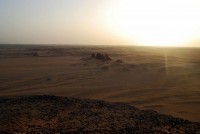


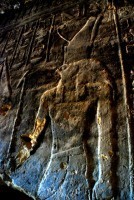
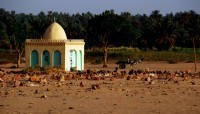
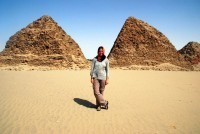

Blog post by Roderick Phillips, author of Weary Heart – a gut-wrenching tale of love and test tubes.
The post The pyramids of Napata, Sudan, Day 296 appeared first on Roderick Phillips.

